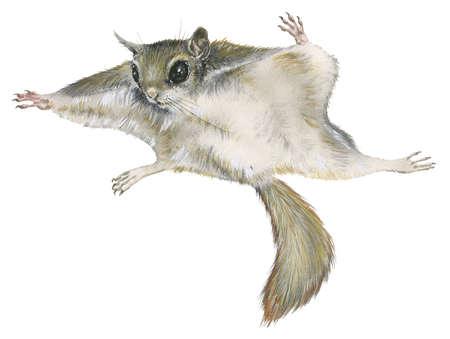Northern Flying Squirrel (Glaucomys sabrinus)
Classification
Kingdom: Animalia
Phylum: Mammalia
Class: Chordata
Order: Rodentia
Family: Sciuridae
Genus: Glaucomys
Species: sabrinus
Systematics:
The only congener of the northern flying squirrel (G. sabrinus) is the southern flying squirrel (G. volans). The northern flying squirrel is distinguished by its larger body size, gray/white belly fur, a furred patagium (fleshy membrane) that extends from the wrist of the foreleg to the ankles of the hindleg, and a more robust baculum. The hybridization of these two species is brought on by several warm winters that resulted in northward range expansion of G. volans and the increase in sympatry between the two species. In Pennsylvania, this trend is intensified by loss/fragmentation of habitat that increases the extent and duration of the overlap between the two species.
Ecology:
G. sabrinus are found in Canada, the northern United States, along the west coast, and into Idaho and Montana. The populations in the Northeast appear to comprise one larger metapopulation that extends through the Poconos. In Pennsylvania, it is reported to extend across the northern third of the state, and southward into Maryland. Most recent records indicate six locations in northeastern Pennsylvania and only one in the western portion of the state. It is reported from a large range of forests
that contain a significant conifer component. The first record of this species in Pennsylvania was reported from a stand of beech (fagus), yellow birch (betula alleghaniensis), and sugar maple (Acer saccharum). Red spruce (Picea rubens) is an important component of the habitat of this species in Pennsylvania. They generally live in deciduous and coniferous forests and woodlands. They tend to make their homes in snags, woodpecker holes, nest boxes, and abandoned nests of birds and other squirrels.
G. sabrinus are found in Canada, the northern United States, along the west coast, and into Idaho and Montana. The populations in the Northeast appear to comprise one larger metapopulation that extends through the Poconos. In Pennsylvania, it is reported to extend across the northern third of the state, and southward into Maryland. Most recent records indicate six locations in northeastern Pennsylvania and only one in the western portion of the state. It is reported from a large range of forests
that contain a significant conifer component. The first record of this species in Pennsylvania was reported from a stand of beech (fagus), yellow birch (betula alleghaniensis), and sugar maple (Acer saccharum). Red spruce (Picea rubens) is an important component of the habitat of this species in Pennsylvania. They generally live in deciduous and coniferous forests and woodlands. They tend to make their homes in snags, woodpecker holes, nest boxes, and abandoned nests of birds and other squirrels.
Diet and Predation:
Diet- G. sabrinus are omnivores that forage on the ground where they engage in a scatter-hoarding behavior. Their diet includes nuts and seeds of various species, lichens and hypogeous fungi, fruits, catkins, staminate cones, insects, and various animal material.
Diet- G. sabrinus are omnivores that forage on the ground where they engage in a scatter-hoarding behavior. Their diet includes nuts and seeds of various species, lichens and hypogeous fungi, fruits, catkins, staminate cones, insects, and various animal material.
Predation- Because of their size, both avian and mammalian predators including owls, hawks, tree snakes, and other climbing mammals feed on flying squirrels. This species relies on its gliding locomotion for predator escape.
Reproduction:
G. sabrinus primarily uses both nest cavities and dreys (leaf and twig nests) for nesting. There are two breeding periods recorded, but in many parts of the range, individuals may only breed once per year. In Pennsylvania, birth of the offspring occurs in late March and August, but recent observations by several authors suggest that breeding may occur later in the spring in other locations. Gestation is thirty-seven to forty-two days, and four young are typically found in a litter. Once the young are born, they rely on their mother's milk for eight weeks.

Threats:
The primary factors influencing the species decline include (1) the loss of older growth conifer and mixed stands as a result of human activity, (2) the declining health of the hemlock forests, (3) competitive pressure, and (4) the hybridization of this species with its congener, the southern flying squirrel (G. volans), in parts of the northeast. The hybridization between the two flying squirrel species contributes to the loss of the genetic integrity of G. sabrinus.
Conservation and Management:
In order to conserve this species, it is recommended that (1) logging of all kinds should cease within a one-mile radius where northern flying squirrels are found, (2) older snags, especially with nest cavities, should be maintained,(3) there should be a more limited level of forest protection within a five-mile radius of locations with known occupation, and (4) there should be efforts to protect hemlock forests and older growth conifers. These strategies are essential for the protection of G. sabrinus.
References:
“Northern Flying Squirrel”- Glaucomys sabrinas. Wildlife Journal Junior. 2015. Web. 16 Apr 2015.
“Northern Flying Squirrel”- Glaucomys sabrinas. Wildlife Journal Junior. 2015. Web. 16 Apr 2015.
“Flying Squirrels”. National Wildlife Federation. 2015. Web. 14 Apr 2015.
Terrestrial Vertebrates of Pennsylvania: A Complete Guide to Species of Conservation Concern edited by Michael A. Steele, Margaret C. Brittingham, Timothy J. Maret, and Joseph F. Merritt
Baker, Rollin H. 1983. Michigan Mammals. Michigan State University Press, East Lansing, pg 236-243.
Wells-Gosling, Nancy. 1985. Flying Squirrels. Smithsonian Institution Press. Washington, D.C.
Studelska, Rebecca.. “Northern Flying Squirrel (Glaucomys sabrinus)”. Northern Edu. 2007. Web. 23 Apr 2015.

No comments:
Post a Comment